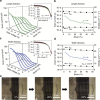Intrinsically stretchable and transparent thin-film transistors based on printable silver nanowires, carbon nanotubes and an elastomeric dielectric
- PMID: 26173436
- PMCID: PMC4518309
- DOI: 10.1038/ncomms8647
Intrinsically stretchable and transparent thin-film transistors based on printable silver nanowires, carbon nanotubes and an elastomeric dielectric
Abstract
Thin-film field-effect transistor is a fundamental component behind various mordern electronics. The development of stretchable electronics poses fundamental challenges in developing new electronic materials for stretchable thin-film transistors that are mechanically compliant and solution processable. Here we report the fabrication of transparent thin-film transistors that behave like an elastomer film. The entire fabrication is carried out by solution-based techniques, and the resulting devices exhibit a mobility of ∼30 cm(2) V(-1) s(-1), on/off ratio of 10(3)-10(4), switching current >100 μA, transconductance >50 μS and relative low operating voltages. The devices can be stretched by up to 50% strain and subjected to 500 cycles of repeated stretching to 20% strain without significant loss in electrical property. The thin-film transistors are also used to drive organic light-emitting diodes. The approach and results represent an important progress toward the development of stretchable active-matrix displays.
Figures








References
-
- White M. S. et al.. Ultrathin, highly flexible and stretchable PLEDs. Nat. Photonics 7, 811–816 (2013).
-
- Xu S. et al.. Soft microfluidic assemblies of sensors, circuits, and radios for the skin. Science 344, 70–74 (2014). - PubMed
-
- Savagatrup S., Printz A. D., O'Connor T. F., Zaretski A. V. & Lipomi D. J. Molecularly stretchable electronics. Chem. Mater. 26, 3028–3041 (2014).
-
- Kim R. H. et al.. Waterproof AlInGaP optoelectronics on stretchable substrates with applications in biomedicine and robotics. Nat. Mater. 9, 929–937 (2010). - PubMed
-
- Filiatrault H. L., Porteous G. C., Stephen R., Davidson G. J. E. & Breen T. Stretchable light-emitting electrochemical cells using an elastomeric emmissive material. Adv. Mater. 24, 2673–2678 (2012). - PubMed
Publication types
LinkOut - more resources
Full Text Sources
Other Literature Sources

